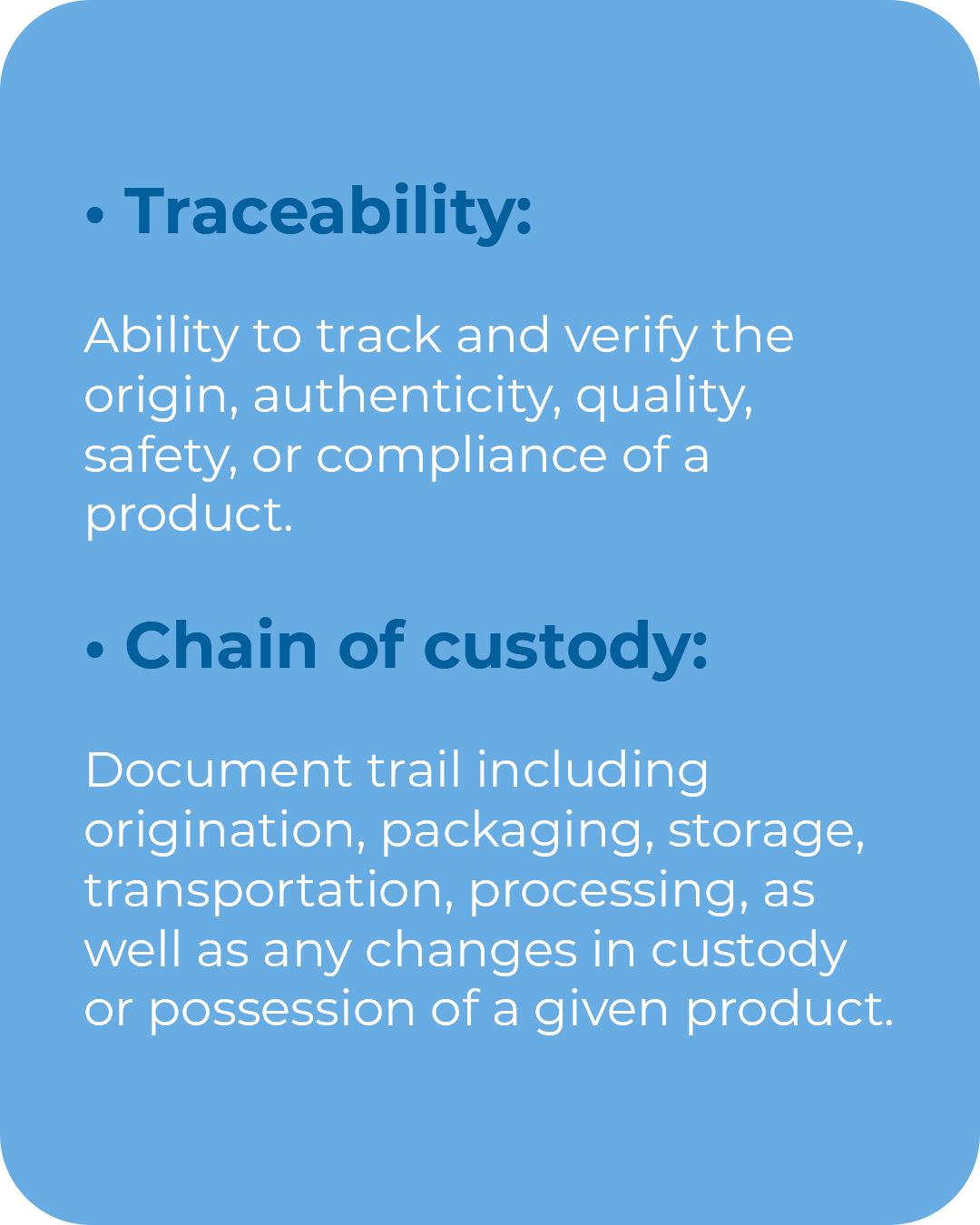Traceability and chain of custody

Traceability and chain of custody are two related/complementary concepts used in various fields, including supply chain management. While they have similarities, they serve different purposes and refer to different aspects of tracking and documenting the movement and handling of items.

Traceability refers to the ability to trace and track the history, location, or application of a product in the supply chain. It requires recording and maintaining detailed records of the origin, processing, distribution, and destination of an item or information.
Chain of custody (CoC) refers to the chronological documentation or paper trail that records the handling and transfer of a product. It establishes a clear record of who has had custody or control of the commodity being traced.
Traceability is therefore a broader concept that encompasses the tracking of items. Chain of custody, on the other hand, is a specific subset of traceability that focuses on the chronological documentation that permits tracking. A robust chain of custody control is necessary to enable traceability.
The CoC forms the basis for any claims that can be made about a product.
Chain of custody models
Chain of custody models are frameworks that ensure the traceability and accountability of a product throughout its entire supply chain. Different models exist. These vary in terms of the level and detail of knowing the source of the product and its sustainability characteristics, and the complexity of implementation. ISEAL[1] has highlighted the following general aspects of CoC models:
- Identity Preservation (IP): In this model, the certified material cannot be physically mixed with other certified or non-certified material. Each lot, batch, quantity, or consignment of certified product is handled separately and is clearly separated from other certified or non-certified products throughout the supply chain, both in physical products and in related documentation.
- Segregation: allows the mixing of certified products/ingredients from different sources certified to the same standards. In this model, the certified material cannot be physically mixed with non-certified material of the same commodity.
- Mass Balance: Certified physical product is not segregated from and may be mixed with non-certified products at any stage of the production process, provided that the quantities are controlled. It requires the reconciliation of inputs and outputs of the certified product. The reconciliation period is the pre-defined timeline within which this process should take place (to avoid indefinite prolongation and subsequent loss of control of volumes that were mixed).
- Book and Claim: Certified and non-certified products flow freely through the supply chain. Sustainability certificates or credits are issued at the beginning of the supply chain and can be purchased by market participants, usually via a certificate or credit trading platform. Outputs are sold with a credit claim corresponding to the amount of certified inputs with no guarantee that there is any certified content in a given lot of the final product.
It is important to keep in mind the consideration of conversion rates/ratios, noting that the volume of inputs versus volumes of outputs depends on the conversion rate of a given product. This is the case for all models of chain of custody where any kind of processing takes place.
The chain of custody models presented above, provide different approaches aiming at ensuring transparency, traceability, and accountability in the supply chain. The specific model chosen depends on the desired level of control, traceability requirements, and the nature of the product or industry involved.
Regardless of the model used, maintaining a proper chain of custody requires the documentation of each transfer, handling, and storage, including details such as dates, times, locations, individuals involved, and any relevant observations or changes to the product.
ProTerra Approach to Traceability and Chain of Custody
The ProTerra certification system is an internationally recognised certification programme for the sustainable and responsible production of agricultural commodities and related products. It focuses on promoting environmentally and socially responsible practices throughout the supply chain. The system includes specific requirements and criteria for chain of custody and traceability.
ProTerra certification requires companies to establish and maintain an effective Chain of custody system. Under ProTerra, Identity Preservation, Segregation and Mass Balance models are possible. ProTerra does not work with Book and Claim, credits are therefore not issued, and only physical flows are considered.
Traceability requirements under ProTerra certification include:
- Documentation: Companies must maintain records that allow the traceability of certified products throughout the entire supply chain. This includes information on suppliers, transportation, storage and processing as applicable.
- Supplier Evaluation: Companies are required to evaluate their suppliers based on ProTerra’s criteria. This evaluation helps to ensure that all core suppliers meet the required sustainability criteria.
- Testing and Sampling: Random testing and sampling of products are conducted to verify compliance with ProTerra’s standards. This helps to ensure that the certified products meet the required criteria (for example non-GMO characteristics and absence of pesticides above the threshold values).
- Auditing: ProTerra’s auditing process includes traceability checks to ensure that the necessary documentation and procedures are in place to track the product’s origin and movement accurately.
The specific ProTerra approaches to the different models of CoC described above are discussed in detail in ProTerra´s Publication: ProTerra Standard Chain of Custody Models
By incorporating a chain of custody and traceability requirements, the ProTerra certification system aims to provide assurance to consumers and stakeholders that certified products are produced responsibly and can be traced back to their source.